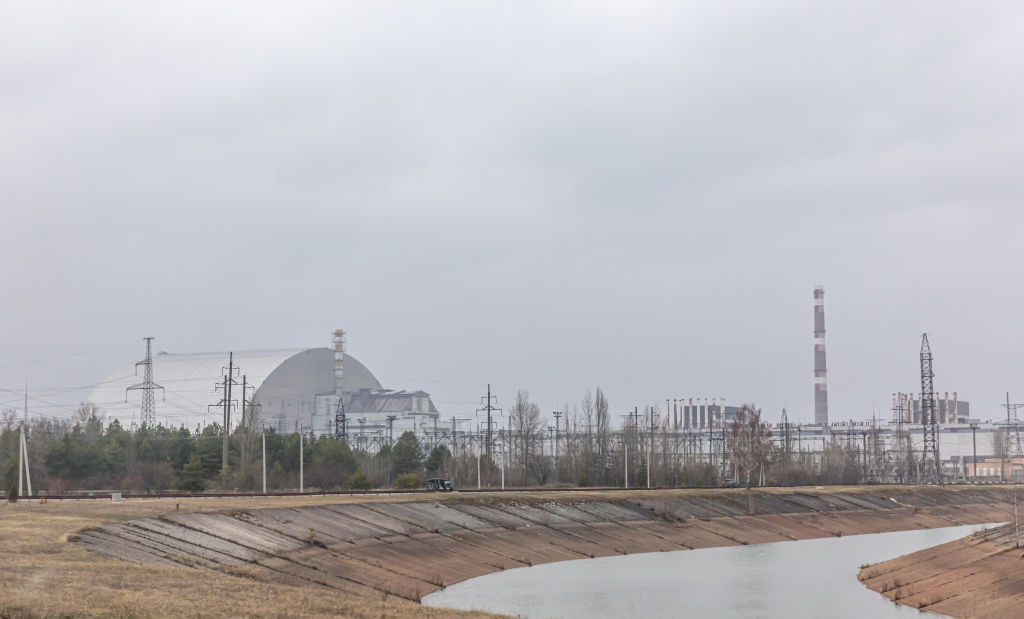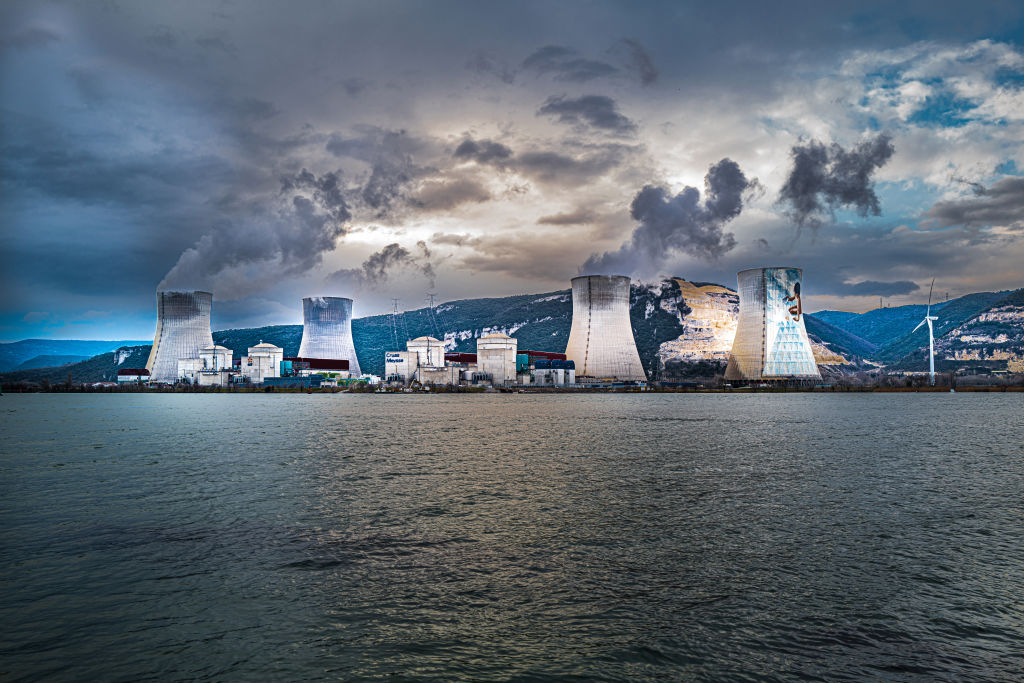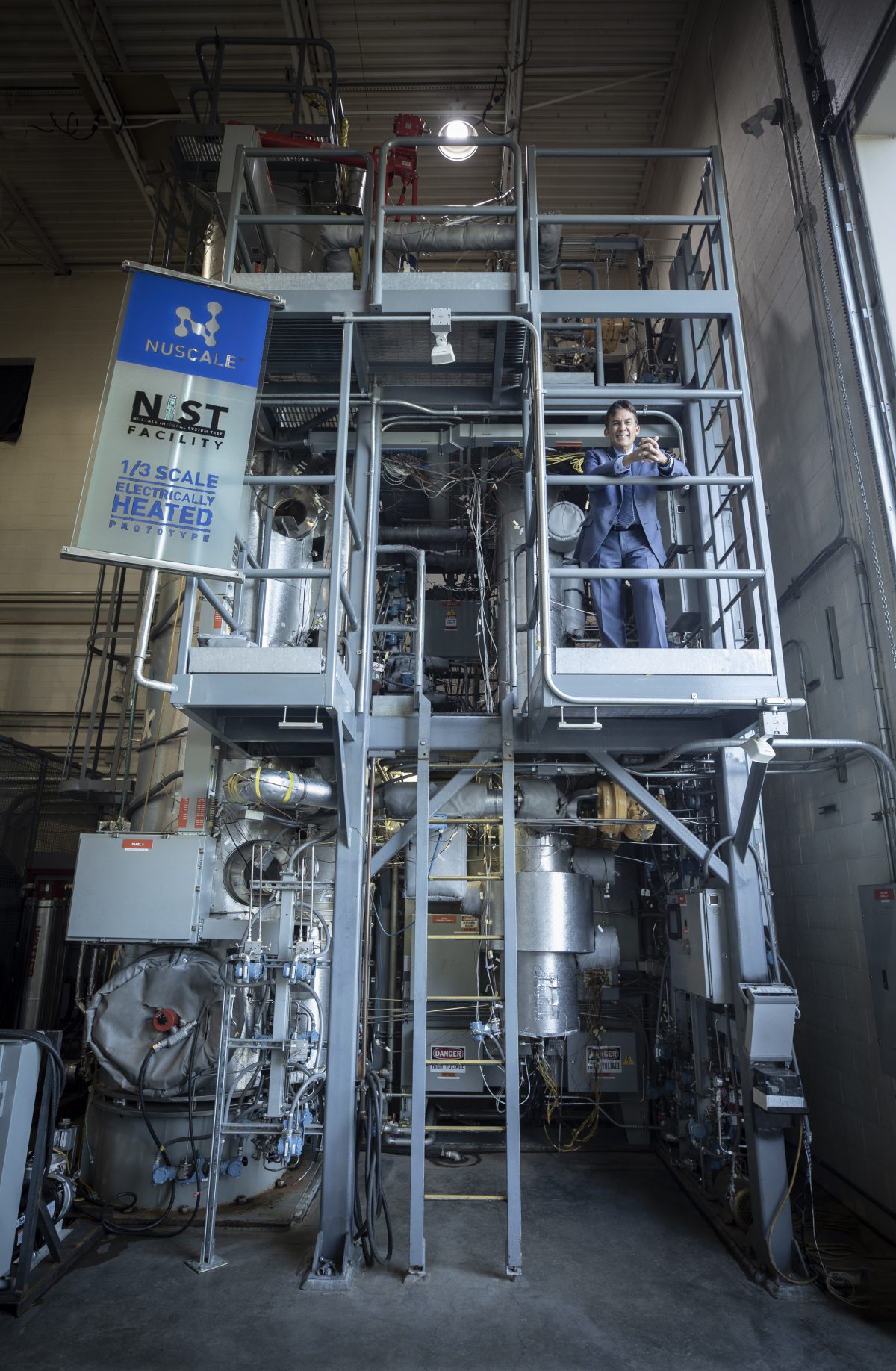
In early March, the world looked on in horror as a fire broke out at Europe’s largest nuclear power plant in southeast Ukraine. The blaze at the Zaporizhzhia facility following shelling by invading Russian forces was eventually brought under control, and no leaked radiation was reported, though the potential for catastrophe prompted Ukraine President Volodymyr Zelenskyy to accuse his Russian counterpart Vladimir Putin of “nuclear terrorism.”
“There are six nuclear reactors there,” Zelensky said of Zaporizhzhia. “In Chernobyl, it was one reactor that exploded, only one.”
By referencing Chernobyl—the nuclear power plant in northern Ukraine that became the site of the world’s worst nuclear disaster in 1986—Zelensky was making the stakes very plain. But strange as it may sound, those scenes at Zaporizhzhia may inadvertently contribute to a new dawn for nuclear power.
The instability resulting from the Russian invasion—as well as mounting evidence of war crimes—has made finding alternatives to Russian oil and liquid natural gas (LNG) a policy priority for European nations who want to stop funding Putin’s war machine. With few options that offer true energy sovereignty, there is now renewed enthusiasm for nuclear energy among politicians in Europe. On April 8, British Prime Minister Boris Johnson announced the U.K. would build up to eight new nuclear plants by 2030 to ensure “we are never again subject to the vagaries of global oil and gas prices” and “can’t be blackmailed by people like Vladimir Putin.”
Across Europe, there has been a growing acceptance that nuclear energy is a vital plinth of efforts to fight climate change, and Russia’s invasion of Ukraine has catalyzed that trend by injecting a national security argument. And as a leader in revolutionary new nuclear technology, the U.S. stands to be the chief geostrategic beneficiary of any revival. The question is whether engrained, ideological aversion to nuclear power in key stakeholder states, particularly Germany, will quell that momentum.
Why Nuclear Power is Back on the Discussion Table
Collectively, the E.U. imported more than 60% of its energy in 2019. Of that, 47% of the bloc’s imported coal came from Russia, along with 41% of its imported LNG, and 27% of its imported crude oil.
The ideal solution is to replace coal and oil with renewables like wind, solar and tidal power. However, despite some great advances in battery technology amid heaps of investment, there is still not a viable storage solution to provide power when the sun isn’t shining, or wind stops blowing. This means each nation’s energy portfolio requires a “firm” element. The cheapest option is simply to swap out dirty coal for comparatively clean LNG, but Putin’s aggression has underscored the hidden costs of that approach. Not only is nuclear energy immune to the vicissitudes of oil and gas prices, it’s also a zero-carbon technology.
Beyond the practically uncountable damage greenhouse gas emissions inflict on the lives and livelihoods of people globally, the air pollution that results from burning fossil fuels directly led to 8.7 million deaths in 2018 alone, according to research published last year. Meanwhile, despite the raft of high-profile disasters, historic fatalities from the civil nuclear industry are measured in the low thousands. In February, the E.U. classified nuclear energy as “green,” drawing a backlash from environmentalists who point to risks associated with accidents and nuclear waste.
But many energy experts counter that it’s a necessary element of a viable net-zero economy. “Nuclear power is an important source of low-carbon electricity and heat that can contribute to attaining carbon neutrality and hence help to mitigate climate change,” wrote Olga Algayerova, Executive Secretary of the United Nations Economic Commission for Europe, in a report published in the lead up to November’s COP26 climate talks. And boosting the capacity of Europe’s existing nuclear reactors—which don’t normally run at full tilt, due to the growing inclusion of renewables—was one of the solutions the International Energy Agency (IEA) recently proposed to reduce European reliance on Russian LNG. “The majority of countries in Europe will be even more pro-nuclear now,” says Kai Vetter, a professor of nuclear engineering at the University of California, Berkeley.
Even before the war in Ukraine, the IEA was saying that the nuclear industry must nearly double in size over the next two decades to meet global net-zero emissions targets. In 2018, the Intergovernmental Panel on Climate Change (IPCC) published a 400-page special report, “Global Warming of 1.5°C,” which offered four pathways to mitigate global temperature rises. All four pathways increased the use of nuclear power in relation to 2010, by an amount ranging from 59% to 106% by 2030, and from 98% to 501% by 2050. Since the invasion of Ukraine, E.U., policymakers grappling with how to wean their nations off Russian energy are seeing nuclear as an increasingly viable alternative.
Why Some E.U. Countries Remain Skeptical of Nuclear
On the other hand, nuclear power remains deeply political in Europe, not least after the 2011 Fukushima meltdown in Japan reenergized anti-nuclear advocates in the region. Perhaps the most important country opposing nuclear is Germany—which also happens to be the E.U.’s largest user of Russian energy. Germany’s ruling coalition partner Green Party has its roots as an advocacy group specifically in opposition to nuclear energy, and the country was about to take its nuclear power offline when the war began. As Russian tanks rolled into Ukraine in February, Robert Habeck, German Vice-Chancellor and a Green Party leader, said he wouldn’t rule out extending the life of Germany’s three remaining nuclear plants on “ideological” grounds. But he soon backtracked and insisted decommissioning would take place as planned. Instead, Germany has gone cap in hand to Qatar and the UAE to seek alternative sources of liquid natural gas despite climate and human-rights concerns. “It’s so incomprehensible,” says Vetter. “There’s amazing naiveté in Germany in my opinion.”
Nuclear power is an issue that splits Europe. Although most E.U. nations are pro-nuclear, at COP26 a group of five—Austria, Denmark, Germany, Luxembourg and Portugal—banded together to urge the European Commission to keep nuclear out of the E.U.’s green finance taxonomy. “We have plenty of evidence of how dangerous nuclear power can be,” Austrian Energy Minister Leonore Gewessler told a COP26 side-event on Nov. 11.
The reasons for each member’s opposition are varied and complex. In Germany and Austria, a sense of powerlessness amid fallout from the Chernobyl disaster melded anti-Soviet sentiment with anti-nuclear. In Portugal, opposition is rooted in historic tensions with neighboring Spain, which has four of its ten nuclear plants using the Tagus River for cooling, which runs into Portugal.
Still, other Western European nations such as Finland, Sweden, France, Spain and Belgium have all historically supported the technology, even while adding renewables like wind and solar. In Eastern Europe, Romania, Czech Republic, Slovakia and Hungary are all beginning or expanding their nuclear capabilities.
Indeed, appreciation of the myriad benefits is swelling alongside the price of oil and gas. “The question of how nuclear power may come back onto the scene was already being discussed because of climate goals,” says a senior Western diplomat in Central Europe, asking to remain anonymous due to official protocol. “Now we have the whole Russian gas question. And again, it’s an answer.”

What Comes Next
Many obstacles remain, of course: Aside from political hesitancy, nuclear plants are expensive, with steep regulatory hurdles. And there is no quick fix: traditional large-scale plants take 10 years to bring online; even the most cutting-edge, next-generation reactors require at least four.
Nevertheless, those next-gen reactors, called Small Modular Reactors (SMRs), can make a difference, say industry watchers. They’re groundbreaking because, as they are modular, with different numbers of “off the shelf” reactors, they can be combined to tailor for specific needs. Rather than being built bespoke to fit on a specific site, SMR modules get shipped to the location by truck, rail, or barge. This makes them more affordable when economies of scale kick in. They are also theoretically much safer, requiring neither manpower nor electricity to go offline in case of a crisis, while also producing less hazardous waste since they are able to “burn” up more fuel. While traditional reactors are ideal for splitting uranium-235 atoms, the neutrons of “fast” SMRs can also split uranium-238, which makes up over 99% of the enriched uranium that’s fed to reactors. This means less frequent refuelings and less waste.
“SMRs could potentially change the game and bring nuclear back,” says the Western diplomat. “There’s a lot of countries looking at this type of technology with different designs for small reactors.”
Oregon-based NuScale is a leader in the SMR field, and co-founder and Chief Technological Officer Jose Reyes has seen an uptick in inquiries since the war in Ukraine, as nations grapple with an increasingly thorny energy conundrum. “We’ve gotten a lot of interest globally,” he tells TIME.
On the sidelines of COP26 last fall, U.S. and Romanian officials inked an agreement for NuScale to build Europe’s first SMR in partnership with local nuclear firm Nuclearelectrica. The collaboration “will contribute to Romania’s energy independence in line with the European vision of protecting the environment and reducing carbon dioxide emissions,” Romanian Prime Minister Nicolae Ciucă told TIME in an interview in March.
Indeed, if the E.U. wants a nuclear energy ascendency, the U.S. is a likely partner. In the U.S., nuclear power is largely uncontroversial—even Democrats and Republicans are united on the benefits—and America’s 93 operating nuclear reactors supply 20% of U.S. power, or about half of its carbon-free electricity. The U.S. has also been pushing the power source as a solution for developing countries, unveiling in November $25 million of funding to help build reactors in Brazil, Kenya, and Indonesia.
In the E.U., the invasion of Ukraine has galvanized an appreciation of nuclear energy. The new mood has been helped by the fact that France—Europe’s most pro-nuclear country, generating over 70% of its electricity via the technology—is the current rotating president of the E.U. Council and controversially added promotion of nuclear power to its presidential program in what one German Green Party member described to TIME as a “f–k you into the face of Germans.” Many other European nations are making a similar calculation. Of the 10 foreign nations that have signed memoranda of understanding (MoUs)—which establishes the groundwork for exploring building an SMR—with NuScale, half are European. In addition, in December NuScale signed an agreement with Ukraine to offer analysis of necessary licensing revisions for SMR deployment funded by a U.S. Trade and Development Agency grant.

NuScale may be the first SMR firm to gain U.S. Nuclear Regulatory Commission design approval but it won’t have the field to itself for long. “There are four or five other [SMR] companies in the United States which I really believe will be on the grid within the next 10 years or so,” says Vetter. “And they will be strongly supported by the U.S. government.”
The potential strategic benefits for the U.S. pushing this technology overseas are clear. Building a nuclear plant is not like coal or gas—the client is locked into dependency for training, fueling, and maintenance. Russia currently leads the world in exporting civilian nuclear technology, but Putin’s invasion of Ukraine has underscored it as an unreliable partner, and the E.U. is currently mulling whether to ban all collaboration with Russian nuclear providers, especially Rosatom and its subsidiaries. If so, Washington stands to boost its geostrategic clout at the expense of the Kremlin.
China could be another potential partner for the E.U. Building more new nuclear reactors than any other country—it plans for as many as 150 by 2030, costing in the region of $500 billion—China will soon overtake the U.S. as the operator of the world’s largest nuclear-energy system. It is also experimenting with SMRs, and given its existing engineering prowess and record of slashing costs, is already offering cost-effective alternatives.
But question marks hang over China’s strategic ambitions amid accusations of coercive practices and debt-trap diplomacy. In November 2015, Romania’s Nuclearelectrica signed a MoU with China General Nuclear Power Corporation (CGN) for the redevelopment of its sole existing nuclear power facility, Cernavoda. However, in August 2019, the U.S. blacklisted CGN over the alleged theft of U.S. nuclear technology for military purposes, and Romania canceled the deal less than a year later. Instead, it has agreed to a deal thought to be worth $8 billion to have the U.S. refurbish and expand Cernavoda.
It helps that the U.S. is a trusted ally. “Our plants are designed for a 60 year life,” says Reyes. “So that’s a long-term relationship that involves supply chain and operations and training. So it’s a natural bond that’s created between nations when you do that.”
German opposition remains the most problematic for the pro-nuclear lobby given the nation’s leadership role within the E.U. One leading Green Party figure, who asked to remain anonymous since energy policy was not his specific brief, tells TIME that any internal dissent regarding doubling down on LNG instead of reevaluating nuclear remains very much a fringe viewpoint. “There are political identity, cultural, and political risk components [to our continued opposition to nuclear],” he says. “And in a situation of crisis like now there are just so many compromises you can sell.”
Certainly, the longer the Ukraine war goes on, extricating nations from Russian oil and gas will stay firmly at the top of Western policy agendas. And the nuclear-over-oil drum is one that Washington, Paris, and others, will keep on banging.
More Must-Reads from TIME
- How Donald Trump Won
- The Best Inventions of 2024
- Why Sleep Is the Key to Living Longer
- Robert Zemeckis Just Wants to Move You
- How to Break 8 Toxic Communication Habits
- Nicola Coughlan Bet on Herself—And Won
- Why Vinegar Is So Good for You
- Meet TIME's Newest Class of Next Generation Leaders
Write to Charlie Campbell at charlie.campbell@time.com